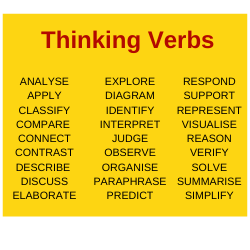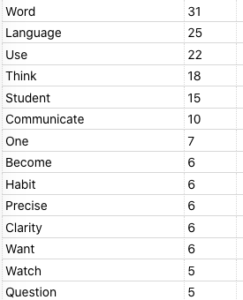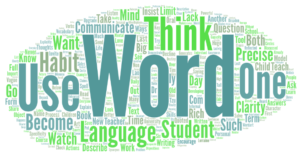Language is the key to great thinking
“Watch your thoughts, they become your words;
watch your words, they become your actions;
watch your actions, they become your habits;
watch your habits, they become your character;
watch your character, it becomes your destiny.” Lao Tzu
I love questions that send my thinking in circles. One such dilemma is the question: Which happens first in child development, thoughts or language? There are claims for both sides and in reality they are so closely intertwined that it makes the question almost non-sensical. Language and thinking are inseparable, you cannot have one without the other.
Our language, or lack of it, however can limit our ability to think and problem solve. Austrian-British philosopher, Ludwig Wittgenstein is quoted as saying, “The limits of my language are the limits of my mind. All I know is what I have words for.”
A compelling statistic discussed in Tim Elmore’s book, Generation iY – Our Last Chance To Save The Future, shows the decline of language over the last century. He states in 1950 the average 14 year old had approximately 25,000 words in their working vocabulary whilst in 1999 this number of words dropped to 10,000. There are many theories and hypotheses to try to explain this. It is , of course, a stunning revelation about the capacity of complex thinking that may have been lost with the lack of language to underpin it.
This is reflected in the vague and imprecise language heard in everyday life. When people describe objects or events with terms such as “nice”, “stuff” or “weird” they are not clearly explaining their thoughts. Generalisations are also abundant. Phrases such as “You never listen to me,” or “Everyone has one” lack the precision of what is really going on. Never? Everyone? Furthermore, advertisers use deletions in their communication in an attempt to be convincing. Statements leave out information such as, “{Product name} is better.” Better than what? This lack of specificity means communication is not as rich and clear as it could be.
Thinking and communicating with clarity and precision is one of the dispositions of intelligent people and has been identified as a key Habit of Mind by Professor Art Costa and Dr Bena Kallick. The habit of striving for clarity, simplicity and precision in both speaking and writing is of great value in all professions, parenting and relationships. Miscommunication is often the source of upset, angst and errors. Using precise language, defining terms correctly, using correct names and universally understood labels leads to both thinking and communicating with clarity and precision. It is important to note that learning this takes time, awareness, modelling and explicit teaching.
Seven ways to explicitly teach this Habit.
- Upgrade their language
In her book, Nothing’s Impossible, Lorraine Munroe shares a powerful strategy for upgrading children’s language skills. In her school she has children aged five and six, reading and discussing senior high school texts with incredible clarity and understanding. Her secret? To not allow students to rest on their laurels using language they already know. For example, when a child uses the word ‘big’ in either oral or written form, and the teacher knows they understand the word ‘big’, they insist on another word for the description. Maybe the child then uses ‘huge.’ Once this word is embedded, the teacher insists on another descriptive word saying, “You already know the word ‘huge’, what’s another word to describe it?” Gigantic, enormous, colossal, tall are synonyms children are encouraged to then use. In turn, with the broadened language skills, thinking becomes sharper and clearer.
- A university word a day
Another technique Lorraine Monroe promoted in her school, was a university word a day. Teachers take the time to teach students a new word a day. Students are then encouraged to find ways to use and integrate the word into their daily communication.
- Modelling
Using rich language in context will also increase student’s thinking and communication capacity. So much of our language has been dumbed down. When I chat to teenagers about this they often admit that if they can’t spell the word, they use a simpler word. Text language may have contributed to the decline of both spelling and precise language use. Text language is here to stay as an informal communication tool, and students need to know the mechanics and language of formal writing and communication. Model this on a daily basis. Use rich vocabulary and unpack new words with students. When demonstrating writing, pause (aloud) and consider the language you are using. Cross out the word ‘big’ and insert ‘massive’ to demonstrate how your learners might think and edit their own work. Take a look at the rubrics you are using with your students, and check the exactness of the language used. Words such as sometimes, often and always are vague and ambiguous, and do not contain the rigour for excellent assessment.
- Insist on full sentences
When you ask students to answers questions in class, both orally and in written form, from day one, insist of students answering in full sentences. There can be a tendency for one word answers, however this limits the thinking and processing opportunities for the mind.
- Replace the term ‘think’ from your vocabulary

As a teacher, when you say “I want you to think about this,” or “Put your thinking cap on,” what specifically do you want students to do? Recall? Analyse? Give their opinion? Describe? These are all very different processes in the brain. Refine your own language to eliminate the word ‘think’ and replace with the thinking verbs you want students to do. On the right is a chart with many of the thinking verbs found in our curriculum documents, These are the ways students are expected to be able to think and process. Use these alternative terms, unpack them and teach them explicitly.
- Tools for upgrading language
One of my personal favourite tools to use and teach is wordart.com combined with thesaurus.com. Students import their written words into wordart.com and the programme generates a list and a word cloud of the frequently used words they have used in their essay, story, analysis etc.
Below is an example from this article in draft form. So far you can see I have used the word ‘word’ 31times and language 25 times. Now I go to thesaurus.com and look up synonyms for ‘word’ and amend my writing. Repeat for other words that you want to modify.


- Do a mental rehearsal and visualise
With younger students, ask them to ‘see’ the concept, idea or object in their mind before they describe it. Encourage them to use their senses of sight, sound, feeling and perhaps taste and smell. Invite them to verbally share the image to a partner in as much detail as possible. This will broaden their awareness, insight and language. For older students, encouraging a mental rehearsal of what they are going to say can assist in their clarity as a speaker and a listener. Invite them to practice how they want to say something inside their head and engage their own internal dialogue by asking questions, developing answers and checking the specificity and clarity of what they want to say.
As with all the Habits of Mind and dispositions, it takes time to learn and personal reflection for growth. On a personal level, read books, study new topics and surround yourself with rich deep conversations which stretch your language and thinking.
As speaker and author Jim Rohn is quoted to say, “If you just communicate you can get by. But if you skilfully communicate, you can work miracles.”
Rudyard Kipling said “Words are, of course, the most powerful drug used by mankind.”
Tags: Habits of Mind, HOM, Karen Boyes, Karen Tui Boyes, language, thinking
Published on Friday, February 12th, 2021, under Habits of Mind, Learning, Teacher Effectiveness

EXPANDING VOACABULARY
This is so true – and also applies to us in Kura Kaupapa Maori using Te Reo Maori.
Thanks